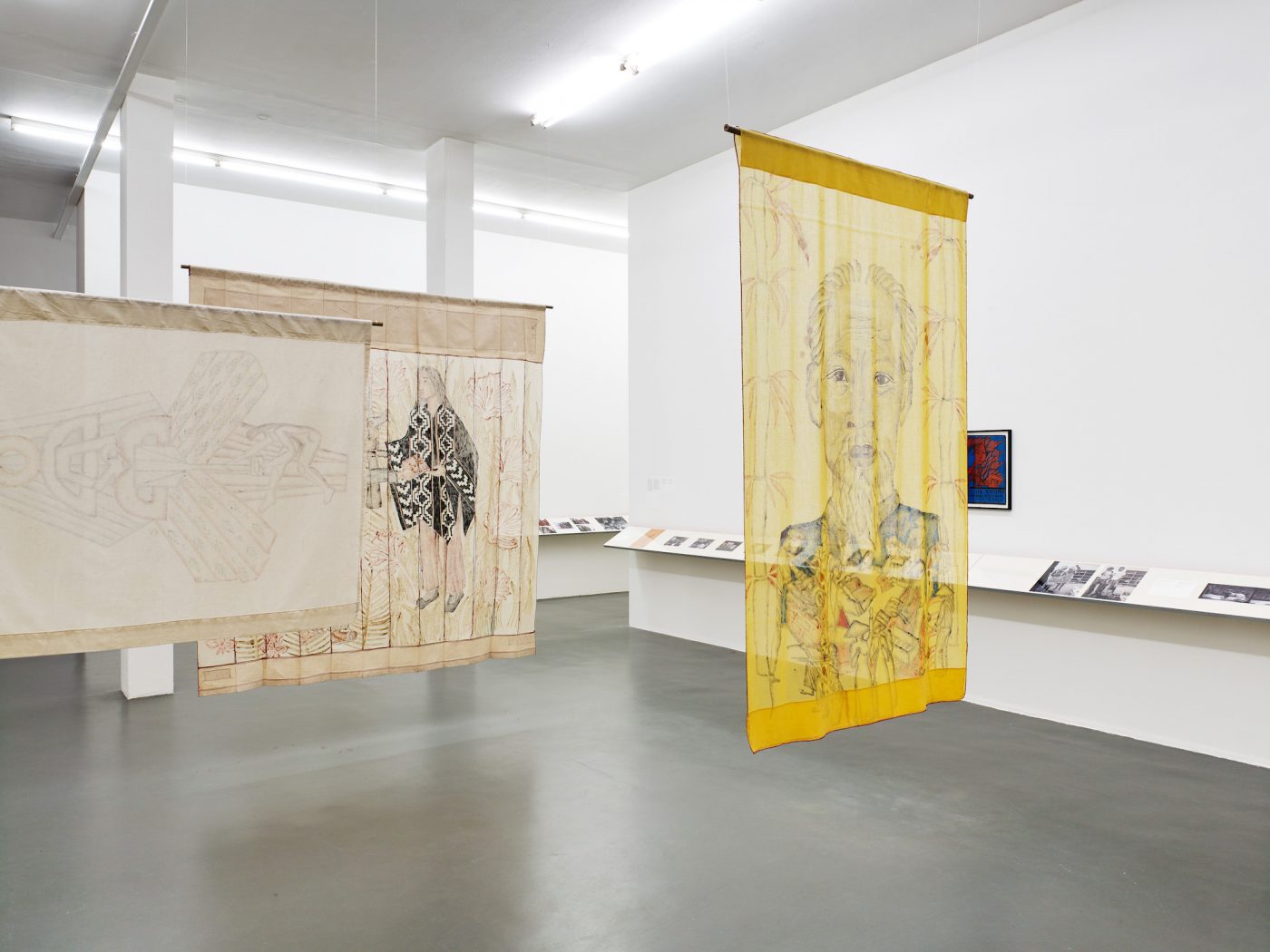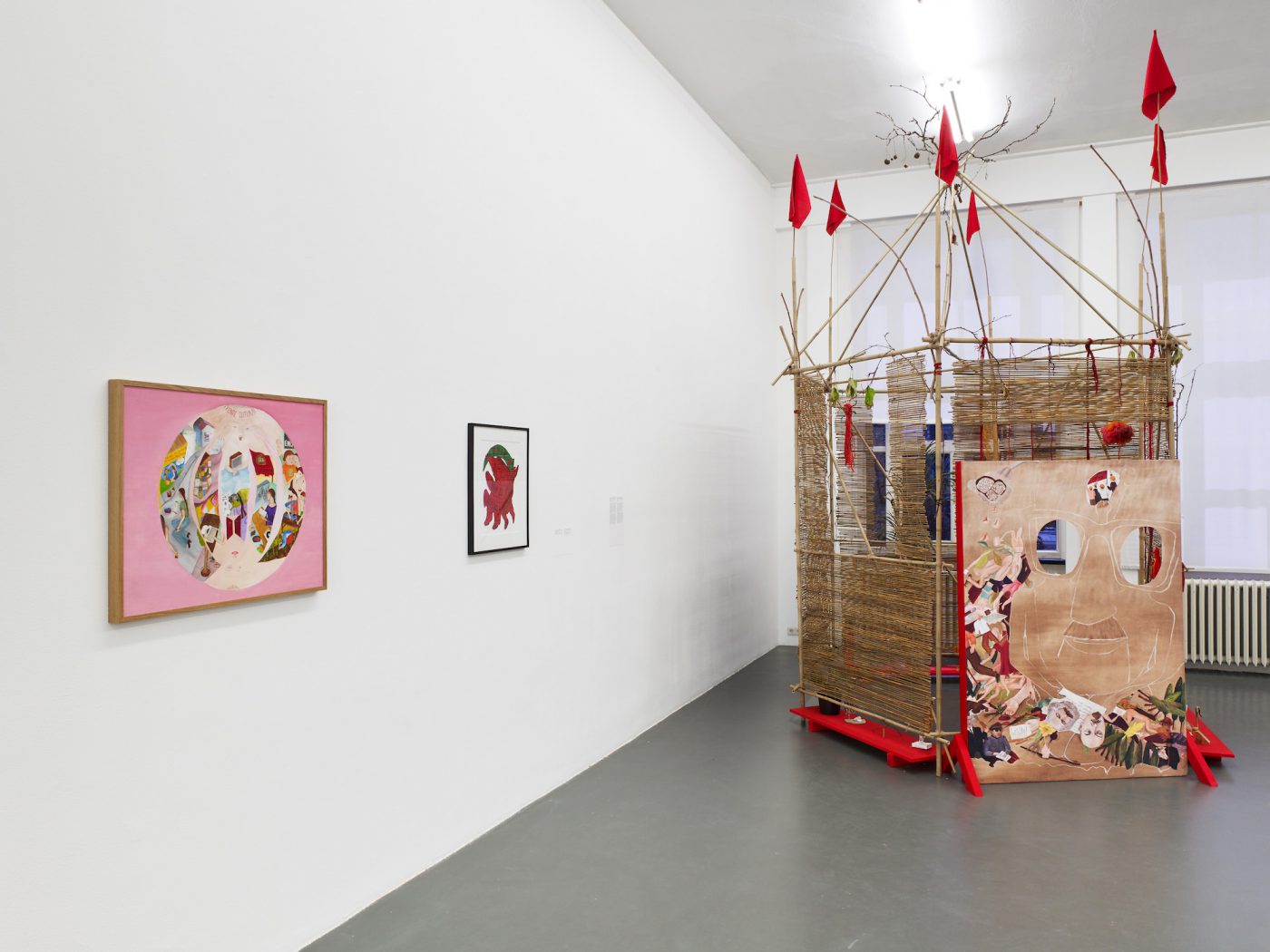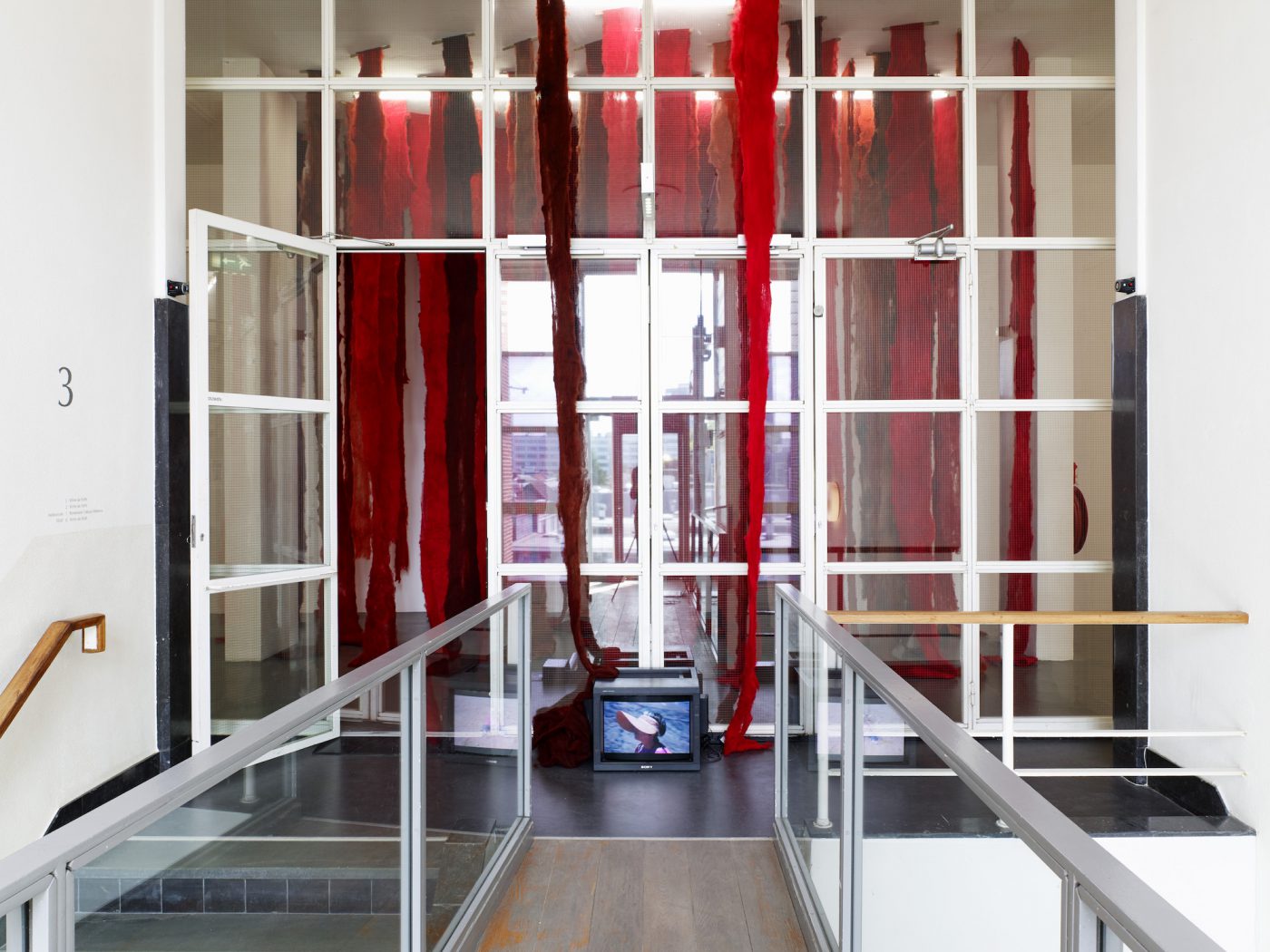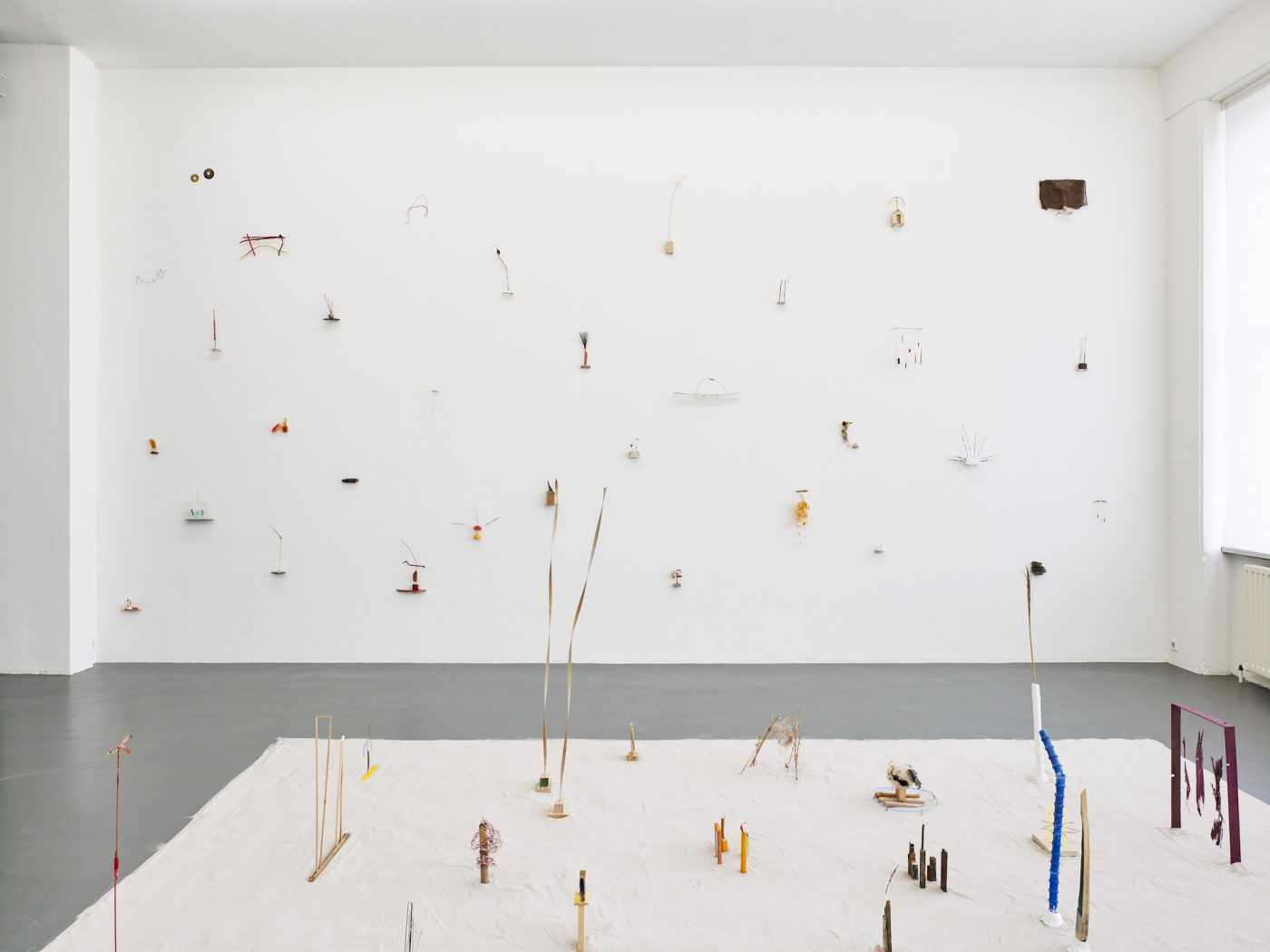
Installation view of a selection of works from the artist’s Art for Democracy series in Cecilia Vicuña, a retrospective exhibition at Witte de With Center for Contemporary Art, 2019. Photographer: Kristien Daem.
“Reconnect water and blood” – Cecilia Vicuña at Witte de With
Cecilia Vicuña’s art and practice serves as an urgent model of sustained activism. In her holistic worldview, the political, environmental and indigenous are thoroughly integrated and must all be equally cared for in order to move beyond a hegemonic world order. Now on view at Witte de With.
A temporary shelter assembled from bamboo and branches. Precarious miniature assemblages of rubbish, found bottle caps, twigs, hair, and seashells. Suspended ribbons of unspun red wool. These are the material artifacts of a sustained practice of political resistance. Since the late 1960s, Chilean visual artist, poet, and activist, Cecilia Vicuña has produced a highly distinguished body of work that juxtaposes ephemeral materials and transient performances with the brute facts of liberation struggles, environmental destruction, and colonial legacies both in South America and elsewhere around the world. Adeptly attuned to and exuberantly celebratory of indigenous culture, Vicuña’s radical practice proposes the healing potential of art to foster socially affective change. A selection of over 100 works—some never before publically exhibited—are included in the artist’s first-ever retrospective exhibition on view at Witte de With until 10 November 2019.
Born in 1948 in Santiago, Chile, Cecilia Vicuña grew up during a period of turbulent political transformation that saw Chile go from an emerging socialist democracy to a rigid authoritarian dictatorship in a matter of years. Soon after receiving her MFA from the University of Chile in 1971, Vicuña moved to London to attend the Slade School of Fine Art. Only months later, a CIA-backed military coup in Chile led to the assassination of the socialist president Salvador Allende and the establishment of General Augusto Pinochet’s seventeen-year dictatorship. While in self-imposed exile, Vicuña began organizing public protests and artistic actions against neo-colonialization, land exploitation, and the destruction of indigenous culture—a practice that the artist has maintained to the present. Now dividing her time between New York and Santiago, Vicuña exhibits internationally, most recently at documenta 14 in 2017 and the Brooklyn Museum and Museum of Fine Arts, Boston, in 2018.
Installed throughout the entire top floor of Witte de With’s exhibition space, the retrospective brings together work from across the artist’s five-decade career. Developed by guest curator Miguel A. López, the show highlights the intersection between art and political activism that defines the oeuvre of this interdisciplinary artist. Comprising painting, installation, performance documentation, video, textile, and archival ephemera, the exhibited works present an appeal to political action that interweaves themes of feminism, indigenous knowledge, and environmental justice.

Installation view of a selection of works from the artist’s Art for Democracy series in Cecilia Vicuña, a retrospective exhibition at Witte de With Center for Contemporary Art, 2019. Photographer: Kristien Daem.
A few of Vicuña’s works made before the coup in Chile are included, however, the first artistic period to be more broadly represented comprises the artist’s early years of activism in London. During this period, Vicuña cofounded Artists for Democracy with David Medalla, John Dugger, and Guy Brett to support the liberation struggles in Chile and Vietnam. While a member of this group, Vicuña created La ruca abstracta (o Los ojos de Allende) (1974/2019), a “spiritual house” for Salvador Allende, which has been reconstructed at Witte de With as a site-specific installation made from bamboo poles, branches, wool, thread, and a portrait of Allende’s face. This installation is supported by archival materials depicting Vicuña and other Artists for Democracy members protesting at Trafalgar Square as well as examples of the pamphlets and brochures that the group distributed and a hand-knitted sweater vest emblazoned with “Chile Vencerá” [Chile will rise] made by Vicuña for Dugger.
In an oil painting made shortly after the dissolution of Artists for Democracy, titled La mulata costeña de Colombia (ca. 1977), Vicuña stylistically pays homage to the Cuzco School of indigenous painters (active from the sixteenth to the eighteenth century) and Soviet and Chinese social realism. She depicts a black woman defiantly marching forward, while carrying a miniature sun, rifle and book in the palm of her hand. Before her are motifs of women working in various industries, the cultivation of gardens, and the celebration of indigenous culture. These scenes signify an emancipated future, which contrast the images of exploitation, violence, and imperialist military intervention that are behind her. This painting exemplifies the merging of the political with the environmental and indigenous that defines Vicuña’s practice. In her holistic worldview, these domains are thoroughly integrated and must all be equally cared for in order to move beyond a hegemonic world order.
In the video, Vicuña lays red lines of yarn, symbolic of menstrual blood, across the rocky mountain terrain, in a ritual that relates to a traditional Andean ceremony
A similar concern for indigenous ontology underlies Vicuña’s precarios [precarious objects], sixty of which are included in the site-specific installation, Pueblo de altares (1990-2019). These small sculptures are presented on a carpet of sand and across one wall of the gallery. Composed of refuse and other found materials, the small totems are evocative of Andean wak’as, or small sanctuaries, temples, and graves. Vicuña first conceived of precarios in 1966, while still living in Chile. Envisioned as either an architecture of the future or the remnants of an ancient culture, the sculptures are playful, minutely detailed, and colorful. These precarios draw attention to our logic of disposability by reclaiming supposedly worthless materials and seeking to elevate them to the sacred. Attesting to the parallel destruction of indigenous culture and the environment, the sculptures provoke an examination of the consumerist mentality that drives globalization.
The various strands of Vicuña’s practice are integrated most poignantly in the installation Quipu menstrual (la sangre de los glaciares) [Menstrual Quipa (the blood of glaciers)] (2006). The quipu is a five thousand year old record keeping system from the Andes that consists of the complex knotting of cords. Vicuña channels this ancient, sensorial mode of communication through an installation of twenty-eight streams of blood red wool that are hung from the gallery ceiling and reach to the floor. Also included is a video documentation of a performance that Vicuña conducted in 2006 at the foot of the Andean mountain El Plomo. In the video, Vicuña lays red lines of yarn, symbolic of menstrual blood, across the rocky mountain terrain. She brings these separate lines together around a small alter composed of stones and condor feathers in a ritual that relates to a traditional Andean ceremony.
This ritual was performed on the day of the presidential election in Chile that saw socialist Michele Bachelet elected as the first female president. In an associated letter that Vicuña sent to Bachelet, of which a copy is presented, Vicuña poetically implores the newly elected president to override approval for Pascua-Lama, a proposed mining project overseen by a Canadian company that would destroy three glaciers in the region for gold extraction. In the letter, Vicuña equates the wellbeing of the environment with the wellbeing of the people. She beseeches Bachelet to “reconnect water and blood,” just as she has attempted to do with her ritualized performance, in order to “end the period of colonial shame.”

Installation view of Quipu menstrual (la sangre de los glaciares) in Cecilia Vicuña, a retrospective exhibition at Witte de With Center for Contemporary Art, 2019. Photographer: Kristien Daem.

Cecilia Vicuña, Pueblo de altares, 1990–2019, site-specific installation including sixty Precarios [Precarious objects]. Courtesy of the artist. Installation view Cecilia Vicuña, a retrospective exhibition at Witte de With Center for Contemporary Art, 2019. Photographer: Kristien Daem.

Installation view of a selection of works from the artist’s Palabrarmas series in Cecilia Vicuña, a retrospective exhibition at Witte de With Center for Contemporary Art, 2019. Photographer: Kristien Daem.
To date, Chilean activists have successfully halted the Pascua-Lama project, demonstrating how activism that integrates indigenous knowledge can go beyond merely imagining a more just and inclusive future. Cecilia Vicuña’s art and practice serves as an urgent model of sustained activism that tirelessly intercedes within the turbulence of our contemporary moment to enact consequential change attuned to the intersections between the environment, culture, history, and politics.
Cecilia Vicuña, a retrospective exhibition, Witte de With, Rotterdam, on view until 10.11.2019
Kiko Aebi


